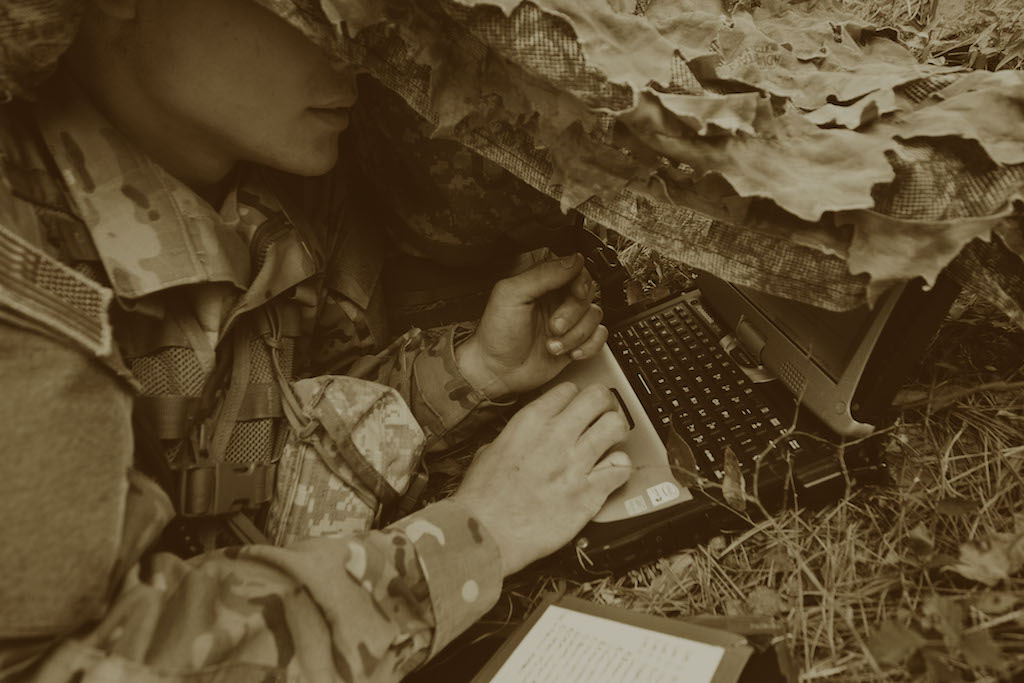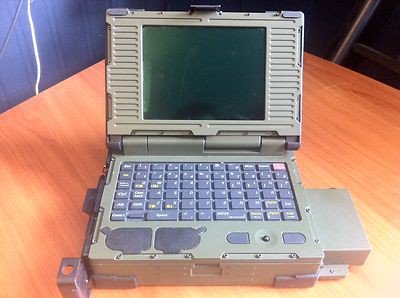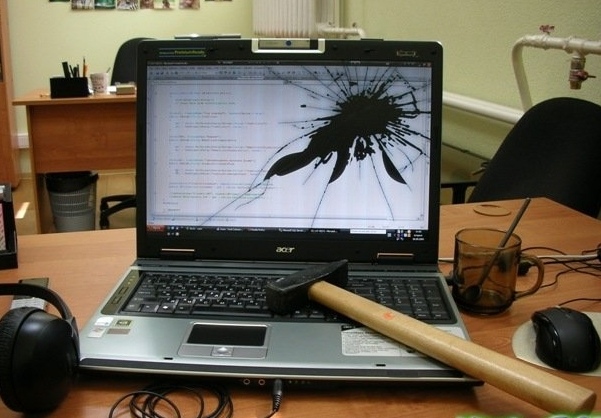Strength test: Termite LT450, LXI
By the early 1990s, modern personal computers came to replace cryptographic machines and other specialized cryptographic devices, in a simple way - PCs. Often it was necessary and necessary to work with such encryption machines in suvory military conditions. Therefore, reliability and durability are the two most important parameters in the development and creation of military portable PCs. Stay unharmed and fully functioning, passing fire, water and copper pipes!

Military-grade computers are unequivocally resistant to physical impact, but due to the use of commercial operating systems (COTS), such as Windows, are rather vulnerable. Because it is so important to consider the availability of an additional block for data encryption.
')
Below are a couple of first military-grade secure laptop computers.

LT450 Termite (photo by CryptoMuseum)
The LT-450N is a very small but reliable personal computer (PC), known as a rugged laptop, designed and manufactured by EDO MBM Technology in Brighton, UK. It was designed to provide secure communications on the battlefield and to control the fire. The machine with a 6.3 or 6.1 inch LCD screen and multiple outputs for connecting peripheral devices is known as TERMITE.
On the right was a small removable cover, under it - two PCMCIA specifications, which are known to have been developed for the standardization of memory expansion cards (usually network cards, modems and hard drives are connected via the PCMCIA interface). For connecting peripheral devices - for example, USB and two serial COM ports (RS232) - at the back of the LT450 was a junction box or adapter.

The LT450 was equipped with a high-quality 6.1-inch color TFT-LCD monitor with a VGA input, used for video surveillance due to its ability to display video in real time. This laptop was also available with a 6.3-inch XVGA screen. On the left was an external power supply. The car was powered by a 7.2 V / 5 Ah lithium-ion battery in a durable rubber casing. The battery could easily be attached to the left side of the case. In offline mode, the laptop worked for 2.5 hours (or 5 hours in energy-saving mode). Using a suitable adapter, the LT450 could work on other batteries, such as BB2800 or standard Clansman batteries.

To ensure secure messaging, the LT450 was equipped with tamper switches and push buttons. Any cryptographic materials (algorithms and keys) were stored in a separate memory block, and not in the PC memory. On the LT450 case, two red buttons were located in front of the keyboard; during the attack the operator had to simultaneously press them (EE1 and EE2). As a result, the algorithms and keys were deleted instantly, even if the laptop was turned off.


The system control unit (SCU) connected to other modules through a complex network of cables. On the front panel were four controls, because of the ease of use, the operator could work with them "blindly."

Messages from the Termite PC could be transmitted via radio RDM 600 (Radio Data Modem), they could also be printed on a durable thermal printer, it was fastened with screws over the SCU 700 system control unit. The printer was equipped with its own lithium-ion battery.

Termite used a set of customizable cables to connect to the various components of the system.

The LT450 was used by the British multinational defense company QinetiQ, headquartered in Farnborough. Later the car was sold to the US Department of Defense (DoD). By 2003, more than 600 LT450 units were removed from service, although most Termite were in operation even before 2010.

LXI is a hardened PC that was developed in 2000 by DRS Technologies in the UK. A durable case, an integrated LCD screen (like a laptop), a removable keyboard and a number of peripheral connections on the back of the device — that's what the safe LXI is all about.

DRS LXI worked on Windows, there was a built-in hard drive. The removable keyboard was easily detached, to the right of the keys was the trackball, which was used instead of the mouse. On the front of the PC, behind the TEMPEST flap, was a removable 3.5 "hard drive.

All connections were located at the back: 15-pin subminiature analog VGA connector (for connecting a monitor), two RS-232 serial ports (COM1 and COM2), 25-pin parallel port for the printer.

The amount of memory could be increased by the SCSI interface. The DRS LXI had a built-in modem and was connected directly to an analog telephone line. In addition, there were connections for ethernet (NET) and BSMS.

Later LXI was improved, the version was seen in the LXI-3 version (2003). In addition to general improvements in performance, disk capacity, and so on, the device is almost identical to its predecessor LXI.
Although DRS’s rugged laptop case protected the device from external ill effects, the laptop was usually packed in a large sealed container. Inside the container was a printer.
These are only two representatives of military-grade laptops, if this topic is interesting - we will continue). Thanks to the magical work of CryptoMuseum

Thank you for staying with us. Do you like our articles? Want to see more interesting materials? Support us by placing an order or recommending to friends, 30% discount for Habr users on a unique analogue of the entry-level servers that we invented for you: The whole truth about VPS (KVM) E5-2650 v4 (6 Cores) 10GB DDR4 240GB SSD 1Gbps from $ 20 or how to share the server? (Options are available with RAID1 and RAID10, up to 24 cores and up to 40GB DDR4).
3 months for free if you pay for new Dell R630 for half a year - 2 x Intel Deca-Core Xeon E5-2630 v4 / 128GB DDR4 / 4x1TB HDD or 2x240GB SSD / 1Gbps 10 TB - from $ 99.33 a month , only until the end of August, order can be here .
Dell R730xd 2 times cheaper? Only we have 2 x Intel Dodeca-Core Xeon E5-2650v4 128GB DDR4 6x480GB SSD 1Gbps 100 TV from $ 249 in the Netherlands and the USA! Read about How to build an infrastructure building. class c using servers Dell R730xd E5-2650 v4 worth 9000 euros for a penny?

Protected laptops are a very special class of mobile devices. They have their own special requirements, even compared to conventional corporate laptops. The main requirement for a protected laptop is to work in adverse environmental conditions and withstand various accidents that may occur during field work. Rain, blows, falls, use at low and high temperatures - this is the most approximate list of what happens with a laptop. Nor does he simply have to withstand it - he must have a sufficient margin of safety so that these events do not go beyond the limits of normal operating conditions.If not all, then most military computers are based on Intel processors and are capable of running popular operating systems, such as Windows, Linux and Unix. Ruggedized PCs are large and heavy, although they consist of a standard keyboard and an LCD screen. Therefore, for use in the field, mobile devices have been developed that, in addition to being reliable and durable, also weigh much less than a ruggedized PC. Such oversized car soldiers can easily carry from place to place.
Military-grade computers are unequivocally resistant to physical impact, but due to the use of commercial operating systems (COTS), such as Windows, are rather vulnerable. Because it is so important to consider the availability of an additional block for data encryption.
')
Below are a couple of first military-grade secure laptop computers.
1. LT450 Termite

LT450 Termite (photo by CryptoMuseum)
The LT-450N is a very small but reliable personal computer (PC), known as a rugged laptop, designed and manufactured by EDO MBM Technology in Brighton, UK. It was designed to provide secure communications on the battlefield and to control the fire. The machine with a 6.3 or 6.1 inch LCD screen and multiple outputs for connecting peripheral devices is known as TERMITE.
On the right was a small removable cover, under it - two PCMCIA specifications, which are known to have been developed for the standardization of memory expansion cards (usually network cards, modems and hard drives are connected via the PCMCIA interface). For connecting peripheral devices - for example, USB and two serial COM ports (RS232) - at the back of the LT450 was a junction box or adapter.

The LT450 was equipped with a high-quality 6.1-inch color TFT-LCD monitor with a VGA input, used for video surveillance due to its ability to display video in real time. This laptop was also available with a 6.3-inch XVGA screen. On the left was an external power supply. The car was powered by a 7.2 V / 5 Ah lithium-ion battery in a durable rubber casing. The battery could easily be attached to the left side of the case. In offline mode, the laptop worked for 2.5 hours (or 5 hours in energy-saving mode). Using a suitable adapter, the LT450 could work on other batteries, such as BB2800 or standard Clansman batteries.

To ensure secure messaging, the LT450 was equipped with tamper switches and push buttons. Any cryptographic materials (algorithms and keys) were stored in a separate memory block, and not in the PC memory. On the LT450 case, two red buttons were located in front of the keyboard; during the attack the operator had to simultaneously press them (EE1 and EE2). As a result, the algorithms and keys were deleted instantly, even if the laptop was turned off.


The system control unit (SCU) connected to other modules through a complex network of cables. On the front panel were four controls, because of the ease of use, the operator could work with them "blindly."

Messages from the Termite PC could be transmitted via radio RDM 600 (Radio Data Modem), they could also be printed on a durable thermal printer, it was fastened with screws over the SCU 700 system control unit. The printer was equipped with its own lithium-ion battery.

Termite used a set of customizable cables to connect to the various components of the system.

The LT450 was used by the British multinational defense company QinetiQ, headquartered in Farnborough. Later the car was sold to the US Department of Defense (DoD). By 2003, more than 600 LT450 units were removed from service, although most Termite were in operation even before 2010.
DRS - LXI

LXI is a hardened PC that was developed in 2000 by DRS Technologies in the UK. A durable case, an integrated LCD screen (like a laptop), a removable keyboard and a number of peripheral connections on the back of the device — that's what the safe LXI is all about.

DRS LXI worked on Windows, there was a built-in hard drive. The removable keyboard was easily detached, to the right of the keys was the trackball, which was used instead of the mouse. On the front of the PC, behind the TEMPEST flap, was a removable 3.5 "hard drive.

All connections were located at the back: 15-pin subminiature analog VGA connector (for connecting a monitor), two RS-232 serial ports (COM1 and COM2), 25-pin parallel port for the printer.

The amount of memory could be increased by the SCSI interface. The DRS LXI had a built-in modem and was connected directly to an analog telephone line. In addition, there were connections for ethernet (NET) and BSMS.

Later LXI was improved, the version was seen in the LXI-3 version (2003). In addition to general improvements in performance, disk capacity, and so on, the device is almost identical to its predecessor LXI.
Although DRS’s rugged laptop case protected the device from external ill effects, the laptop was usually packed in a large sealed container. Inside the container was a printer.
These are only two representatives of military-grade laptops, if this topic is interesting - we will continue). Thanks to the magical work of CryptoMuseum

Thank you for staying with us. Do you like our articles? Want to see more interesting materials? Support us by placing an order or recommending to friends, 30% discount for Habr users on a unique analogue of the entry-level servers that we invented for you: The whole truth about VPS (KVM) E5-2650 v4 (6 Cores) 10GB DDR4 240GB SSD 1Gbps from $ 20 or how to share the server? (Options are available with RAID1 and RAID10, up to 24 cores and up to 40GB DDR4).
3 months for free if you pay for new Dell R630 for half a year - 2 x Intel Deca-Core Xeon E5-2630 v4 / 128GB DDR4 / 4x1TB HDD or 2x240GB SSD / 1Gbps 10 TB - from $ 99.33 a month , only until the end of August, order can be here .
Dell R730xd 2 times cheaper? Only we have 2 x Intel Dodeca-Core Xeon E5-2650v4 128GB DDR4 6x480GB SSD 1Gbps 100 TV from $ 249 in the Netherlands and the USA! Read about How to build an infrastructure building. class c using servers Dell R730xd E5-2650 v4 worth 9000 euros for a penny?
Source: https://habr.com/ru/post/420121/
All Articles